Christmas is the most important and most celebrated holiday in Germany and is very much enjoyed by children and parents alike. However, the Holiday season and pretty much the entire month of December (even the last week of November) demands a lot from parents in Germany. Preparing for the festivities is very time consuming and due to extreme sugar consumption you’ll see more kids bouncing off the walls and driving their parents insane than in any other month – as the following Christmas traditions will attest.
Adventskalender (Advent calendar)

“The Advent calendar was first used by German Lutherans in the 19th and 20th centuries and is a special calendar used to count the days of Advent in anticipation of the celebration of the Nativity of Jesus at Christmas.” While the Adventskalender is still used to count down the days in December, the anticipation nowadays has changed and can be described as a) the anticipation of opening the next door of the calendar to see a new little gift every day and b) the anticipation of getting closer to finally receiving the “big one” on Christmas Eve.
Now, while those were rather joking remarks, December is every German child’s favorite month of the year. Every single day in December kids receive a little goodie that - in 95% of all cases - consists of some sort of chocolate or candy. The goodies are hidden in the Adventskalender, which can be a simple chocolate or candy Adventskalender that you can buy at any store on any corner, or a reusable Adventskalender which is also available in stores, but often lovingly made by crafty parents and children themselves. If you go for the latter, like we do (see below), you do need to start thinking of gifts in November in order to get the calendar filled by December 1st (let the stress begin…). I filled ours with little chocolates and candy, hair bands, mini books, quarters, and 2 puzzle pieces per child per day.

Weihnachtsgebäck (Christmas Cookies)
Germans love their Christmas cookies and bake and eat lots of them. All December long. Many people start baking in November or the beginning of December to have cookies for the 1. Advent (first Advent, which is the first Sunday in December) and Nikolaustag (Saint Nicholas Day).
So, in addition to the goodies that are revealed from the Adventskalender every day, kids devour vast amounts of cookies at home, at family gatherings, at school, or just anywhere (more SSUUUUGAARRR).
German Weihnachtskekse are made from different types of dough with various spices like cinnamon, gloves, cardamon, orange and lemon peels, rum and vanilla, and are decorated with sugar and chocolate sprinkles, nuts, almonds, or completely covered with chocolate.

Some of the most popular ones are Lebkuchen (gingerbread), Spekulatius (speculaas cookies), Spritzgebäck (spritz cookies), Makronen (macaroons), Zimtsterne (cinnamon stars), Vanillekipferl (vanilla crescents), and others.
Many of those cookies take a lot of time to make and of course they don't last long so you have to make several batches and it seems like you're baking cookies all December long.
Our Mom made up to 15 different cookies when we were kids. I didn't inherit her patience and kitchen skills, so 4 different kinds of cookies was my max this year: Butterkekse, Vanillekipferl, Schokokekse, and Marmeladenkekse (thumbprints), see below.
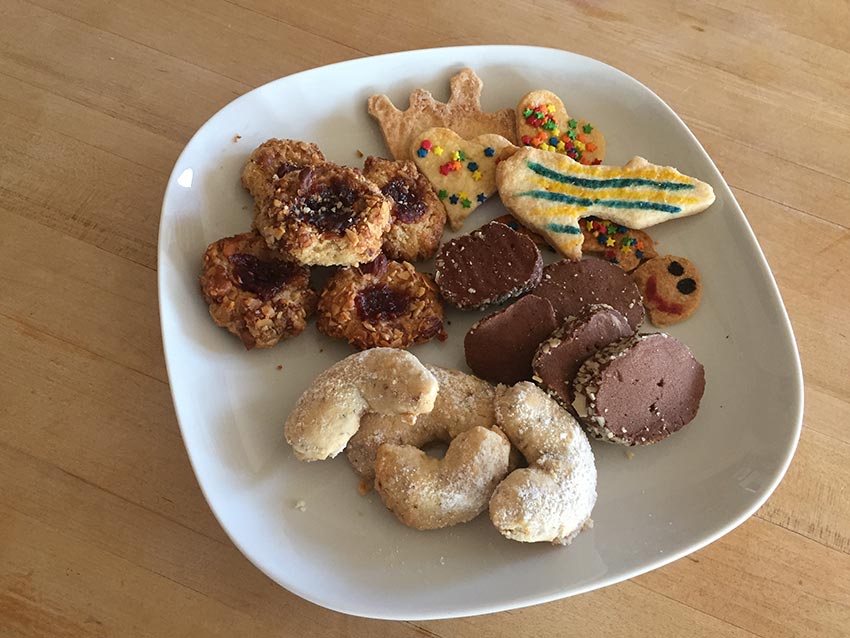
Adventskranz (Advent wreath)
"The concept of the Advent wreath originated among German Lutherans in the 16th Century and a Protestant pastor in Germany and a pioneer in urban mission work among the poor was the inventor of the modern Advent wreath in the 19th century."
The Adventskranz is an evergreen wreath with four candles representing the four weeks of Advent. During the season of Advent one candle on the wreath is lit each Sunday until all of the candles are lit on Christmas Day. The modern day Adventskranz comes in many different shapes and not necessarily in ring form. Just like the Adventskalender, Advent wreaths can be bought in stores but many people enjoy making their own (did I already mention that preparing for Christmas is time-consuming?).

This year, our Adventskranz was a super easy Advent arrangement rather than a wreath that took a mere 5 minutes to create (would have been 2 minutes had the kids not fought over who’s putting which evergreen where). The reason why our candles still look 85% new is that we have two kids and they don’t burn very long (meaning, the candles). The good thing about that is that I get to smell the awesome smell of blown out candles (20 times in a row) throughout all of our family meals.
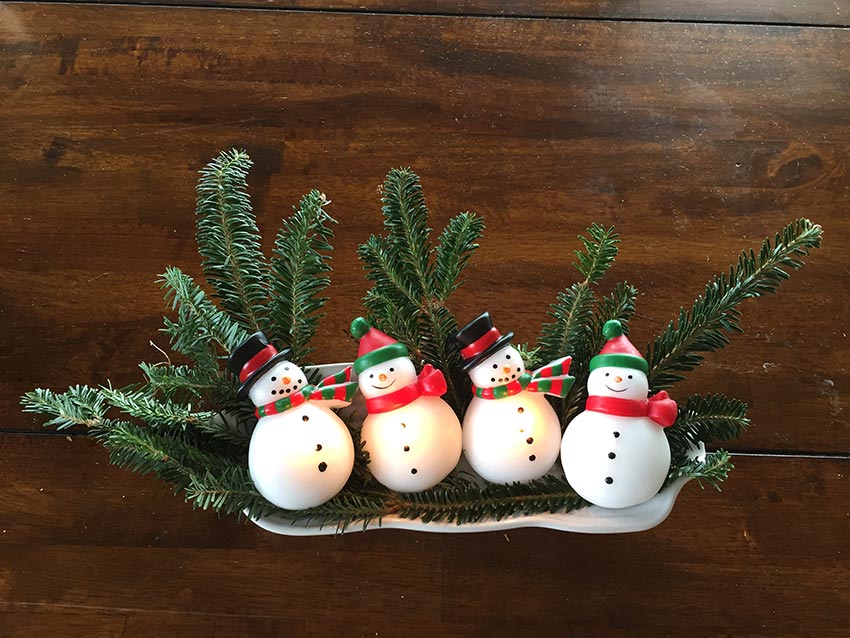
Nikolaustag (Saint Nicholas Day)
Now back to the sugar.
"Each year on December 6th, Germans remember the death of Nicholas of Myra who died on that day in 346. He was a Greek Christian bishop known for miracles and leaving secret gifts in people’s shoes overnight, and is now the patron saint of little children, sailors, merchants and students."
On the night of December 5th, children put a boot called Nikolaus-Stiefel (Nikolaus boot) outside the front door. Nikolaus fills the boot with gifts and sweets overnight. Although they have similar outfits, Nikolaus is not to be confused with Santa Claus, who Germans call the Weihnachtsmann, or Father Christmas.
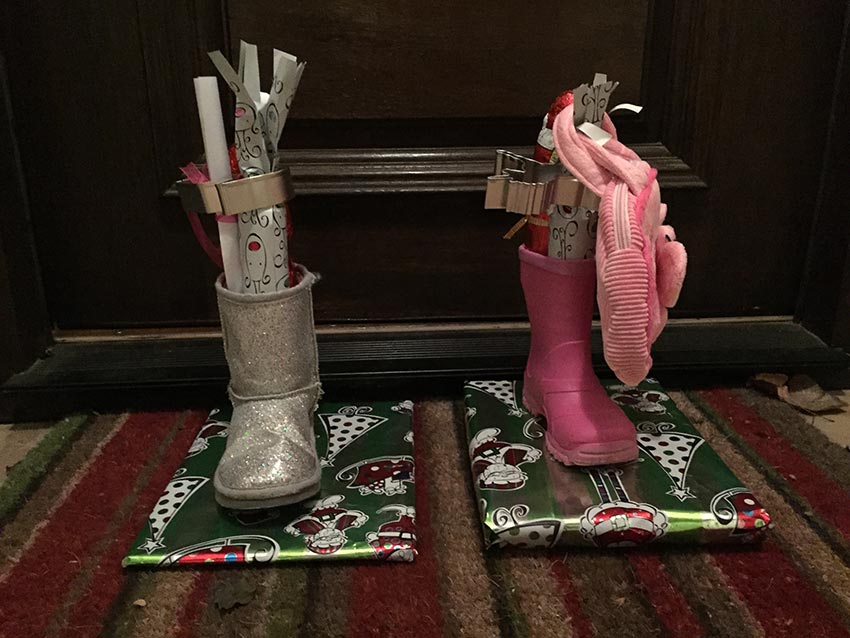
Sometimes a disguised Nikolaus visits children at school or in their homes, alone or with his with his sinister-looking alter ego Knecht Ruprecht, to question the children about their behavior. If kids were good, they get little presents from Nikolaus. Have they been bad, Knecht Ruprecht smacks them with a rod! (not really)
Weihnachtsdekoration (Christmas decoration)
During the Holiday season you’ll find Christmas decoration everywhere. While Germans don’t necessarily decorate the outside of their houses like people do in the United States, the inside of their houses is beautifully decorated with the Adventskranz (Advent wreath), the Räuchermännchen, the Weihnachtspyramide (Christmas pyramid), the Weihnachtskrippe (Nativity scene), and of course the Weihnachtsbaum (Christmas tree).
We’ve already discussed the Adventskranz above.
Räuchermännchen (incense smoker)
The Räuchermännchen is an invention of toy makers in the Ore Mountains, Germany and was first mentioned in 1850. It is now a common component of German Christmas traditions. The Räuchermännchen is a beautifully carved wooden figurine. A lit cone incense is put on the lower part of the figurine. The upper part is hollowed out and put on top of the first part. The cone incense burns down inside of the hollow figurine and the smoke is leaving the mouth hole of the Räuchermännchen creating pleasant scents around the house. Scents range from traditional "Christmas scents" like frankincense, pine, honey and cinnamon, to gingerbread, chocolate, vanilla, lavender, and others.

Our Räuchermännchen sits on our fireplace mantle, smoking his pipe and making our house smell a tiny piney. The girls love watching the smoke come out of his mouth.
Weihnachtspyramide
The Weihnachtspyramide is a Christmas decoration that has its roots in the Erzgebirge (Ore Mountains) of Germany. It is a kind of carousel with several levels; the spinning motion of the pyramids is traditionally achieved with the help of candles whose rising heat spins a propeller above. Most pyramids demonstrate nativity scenes including the story of the Christ child being born, of shepherds and wise men visiting the child, and of angels rejoicing in heaven.
Our pyramid does demonstrate nativity scenes and the kids love the sheep and the cows and “the little baby” and “the kings bringing presents for the baby” (great way to teach them about the Christmas story). They’re also obsessed with the fact that the Weihnachtspyramide spins and – you guessed it – with the candles. This is also your chance to put on your science hat and explain to them the laws of thermodynamics (you’ll be surprised, they really dig it and remember it the following year).

Weihnachtskrippe (Nativity scene)
The Weihnachtskrippe can be both, inside or outside Christmas decoration. You’ll find nativity scenes in people’s houses as well as in their front yards. They’re also very common in or in front of churches or in town centers.

We don’t have a Weihnachtskrippe in our house here in Texas, but pretty much everybody in my family in Germany has one. In addition to the Krippe, my parents also have those beautiful angel figurines that cook Christmas dinner, bake cookies, and clean the house. I would love to have those and then somehow make them come to life and help me with all of the above.
Weihnachtsbaum (Christmas tree)
Yes, I know. Everybody and their dog has a Christmas tree, BUT: “Modern Christmas trees originated during the Renaissance of early modern Germany. The first recorded Christmas tree can be found on the keystone sculpture of a private home in Turckheim, Alsace (then part of Germany, today part of France), dating 1576.” That was waaaayyyy before the United States of America were founded! ;-)
Anyway.
Most Germans have natural Christmas trees that are decorated with baubles, wooden figures, straw stars, tinsel, ribbons & bows, and: real candles! I remember how my brothers and I fought over who’s turn it was to blow out the candles before we went to bed (it smelled soooo good) and, when we were a little older, over who’s turn it was to light the candles and burn their fingers on the lit matches.
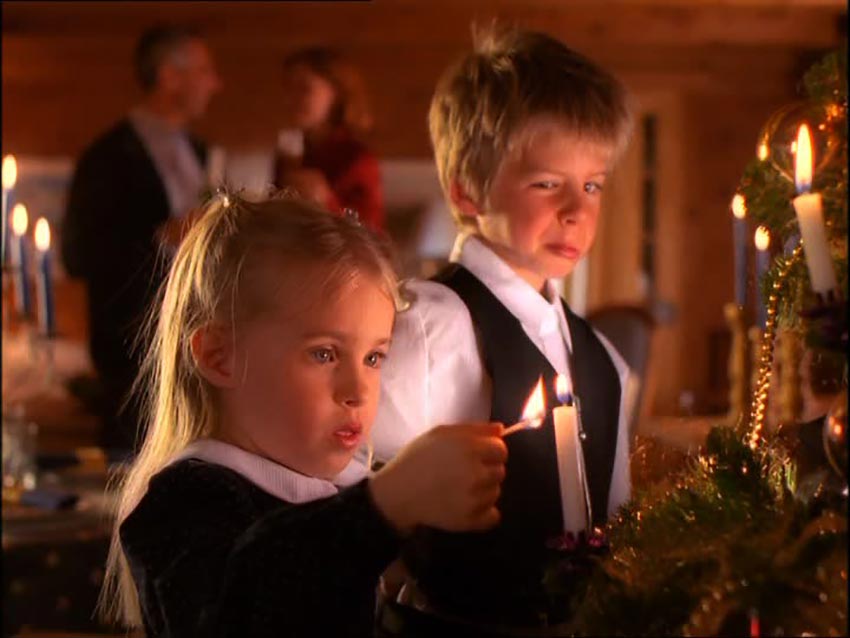
Many families don’t set up and decorate their trees (oftentimes children don’t help with the decorating and don’t see the tree) before Christmas Eve. Depending on whether the family is Protestant or Catholic, the tree is usually taken down on January 6th or on February 2nd.
We do have a natural tree (love the smell) and our decoration is a mix of everything, baubles, wooden and plastic figures, tinsel, and decoration that we and the kids grafted ourselves. While we love the real candle idea, with two little kids and a cat, we go the safer route and use Christmas lights.
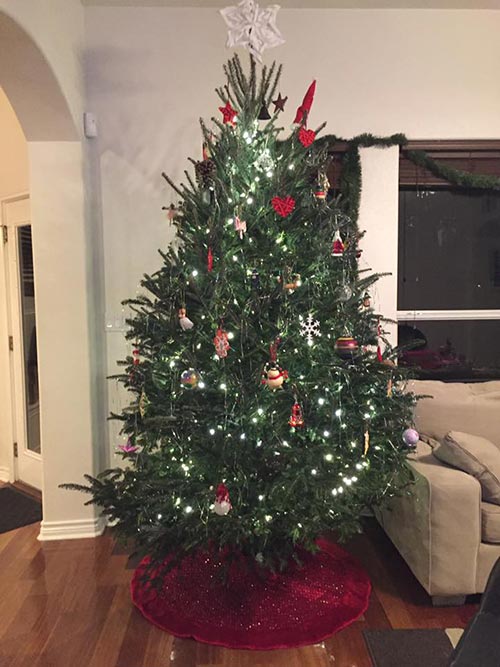
Three days of Christmas festivities
German Christmas festivities last for 3 days: Heiligabend (Christmas Eve), 1. Weihnachtsfeiertag (Christmas Day), 2. Weihnachtsfeiertag (St. Stephen's Day).
Heiligabend (Christmas Eve)
Heiligabend is the most important day of the German celebration. There’s no Santa Claus coming down the chimney, no reindeer, and most importantly: no waiting for Christmas morning! The Bescherung, the exchanging of gifts, takes place right then on Christmas Eve either before or after dinner. Families with young children often keep the living room closed off, revealing the Christmas tree to the excited youngsters only at the last minute. The gifts are delivered by the Christkind, usually depicted with blond hair and angelic wings.
1. Weihnachtsfeiertag (Christmas Day) and 2. Weihnachtsfeiertag (St. Stephen's Day)
The 1. Weihnachtsfeiertag and the 2. Weihnachtsfeiertag are usually celebrated with additional family members like grandparents, aunts, uncles, and cousins. Many families spend the 1. Weihnachtsfeiertag with one side of the family and the 2. Weihnachtsfeiertag with the other. Both days are equally important for kids as they both mean more good food, lots of fun, and of course a whole lotta more presents. Depending on whether your family visits you or you visit them, this means another day or two of cooking, cleaning, and preparing for your guests. Easy fix: find an excuse why the 1. Weihnachtsfeiertag and the 2. Weihnachtsfeiertag should not take place in your house.
So, all of that does sound a little scary, but, trust me, it’s all worth it and I wouldn’t want to have it any other way (although I do since I now live here and Germany and my family is sooo far away, sniff).
And if any of the above ever gets to you, there’s one more German Christmas tradition that will for sure help you get through it all and make the Holidays even more enjoyable:
Glühwein (mulled wine)
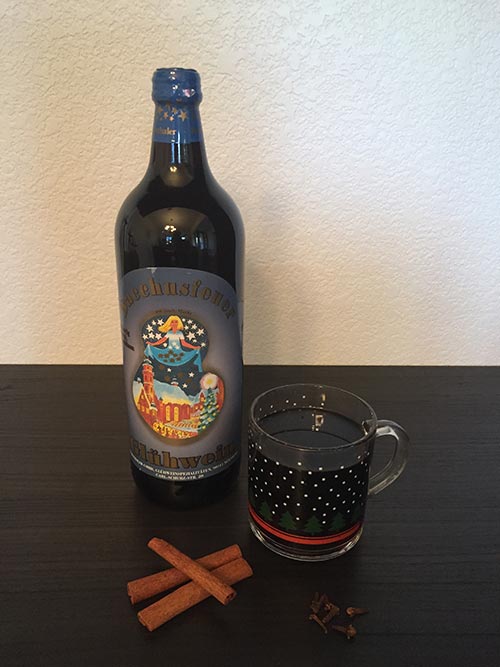
Glühwein is a traditional beverage that is offered during the Christmas holidays and is prepared from red wine, heated and spiced with cinnamon sticks, cloves, star aniseed, citrus, sugar, and vanilla pods. If you're desperate, you may add a shot of rum or some other liquor.
You can buy Glühwein in any grocery store (even here at HEB, Central Market, Trader Joe’s, and World Market) but it’s very easy to make your own. Here’s the recipe:
Ingredients:
1 bottle red wine (dry, robust, and fruity red wine for best results)
1 lemon, sliced
1 orange, sliced
2 cinnamon sticks
3 cloves
3-4 tbsp sugar, depending on taste
100 ml water
3 cardamom pods (optional)
1 star anise (optinal)
Recipe:
Pour red wine into saucepan
Add spices, one by one
Use medium heat, stirring occasionally, until sugar is dissolved
Reduce to low heat for approximately 30 minutes, stirring occasionally
Ladle German Glühwein into mugs
Put a strainer over the mugs to remove bits of spices
Add cinnamon stick for garnish, if desired
Add a shot of kirsch liqueur to each mug first, if desired
Enjoy
Be warned: Glühwein is very strong and it doesn’t take much of it to turn the Holiday season into the best season of the year.
Get the Scoop
Like reading our blog? Get our blog posts delivered via email and follow us on Facebook!